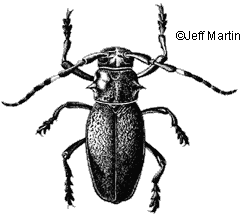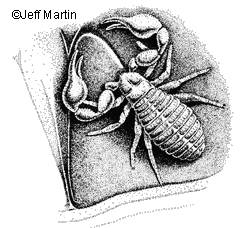Insects and the Saguaro
The saguaro, Carnegiea gigantea, is a well-known symbol of the Sonoran Desert. Watching over the scrub-like flora from its lofty height, this “sentinel of the desert”appears to be a protector of our unique landscape. It seems impervious to herbivores with its tough outer skin and latticework of spines, although packrats are known to eat spiral tunnels up the stems under extreme environmental conditions. But the saguaro is a survivor; such small indignities do it little harm.
Most insects associated with the living saguaro do little damage to the cactus. The Gila Woodpecker and Gilded Flicker, however, peck holes into the saguaro, creating new niches for themselves and for other desert dwellers. These holes heal and become the familiar “boots,” nesting sites for the woodpeckers and later for other birds such as Elf Owls. Beneath some of the slightly hardened calluses of the boots, a small, horned scolytid beetle, Cactopinus hubbardi, sculpts galleries. This minute rhinoceros beetle is an artist-in-residence, creating mini-designs of intricate form, although unfortunately it is usually unseen by an appreciative audience.
Early in the life of a saguaro, when a nurse plant protects it and growth is slow, a jet-black, longhorn beetle, Moneilema gigas, may find a seedling saguaro and consume it. Normally, this beetle feeds on cholla or prickly pear cacti, but like many other of Nature’s creatures, it takes advantage of the young and relatively defenseless.
Flowers act as attractants to much of the animal world, whether with beauty, odor, or food. Arizona’s state flower, the saguaro blossom, is no exception—it draws bats, bees, flies and beetles to its rich smorgasbord.
If we were able to look into the flower we might be startled to see the anthers move without the aid of wind or other devices. How is this possible? Probing deep into the base of the flower, we might discover a small sap beetle, Carpophilus longiventris. This beetle wanders about feeding on pollen grains, then seeks a place to lay eggs. The eggs hatch quickly, and larval development is rapid since the larvae, feeding on pollen or decaying flower tissues, must leave the flower before it shrivels and drops off. The larvae pupate underground. These beetles have no effect on the developing saguaro fruit.
In the fall when life in the desert begins to slow, after the summer monsoon season has ended, secretive termites start their recycling activities. Overnight, mud covers the base of the saguaro where barky material has formed. If the mud is scraped away, small white insects rush for cover. These are the desert-encrusting termites, Gnathamitermes perplexus. It is their job to recycle dead plant material, scraping off and eating the outer layers and returning them to the soil for next year’s plants to feed upon. Termites are not saguaro killers, but soil enhancers.
 |
With death the saguaro becomes really important to insects. When this stately cactus falls victim to Erwinia, a bacterium, or to other problems that begin the decay process, it becomes an oasis to numerous insects and other arthropods, providing food, moisture, shaded habitat or an enticement for predators seeking live food. Carve off a piece of tough outer skin of a decaying saguaro, and you’ll find the innards teeming with life. Move the whole saguaro, and spiders race from beneath it, escaping exposure to sunlight.
The sheer size of insect populations is always amazing. A small chunk of rotting saguaro (about 1 cubic foot, or 2300 cm3) was examined at the University of Arizona; it yielded 413 individual arthropods, including adult and larval beetles, larval flies, pseudoscorpions, and mites. Compare that small portion to the size of a whole saguaro and you instantly understand why insects are this planet’s dominant life form.
A closer look at the fauna in a rotting saguaro will expose an ecosystem with grazers on fungi, such as the feather-winged beetles Acrotrichis and Nephanes, and such recyclers of plant matter as the flattened, leathery syrphid fly larvae Volucella, the neriid cactus fly maggots Odontoloxozus longicornis, and numerous phytophagous mites. This habitat is no longer solid plant material, but is now quite aquatic in nature. Several hydrophilid beetles, Agna capillata and Dactylosternum cacti, may be seen swimming awkward strokes through the muck. They feed on a wide assortment of organic material, from fungus and dead plant matter to castoff exoskeletons and dead insects. What better pond is there in the desert?
And what would an ecosystem be without predators? They swarm to this bountiful table in hordes—all sizes of rove and hister beetles, each staking claim to a prey size suitable to its mandibles. Most are colored red, so an observer may readily spot these hungry terrors of the bug world as they stalk their prey through the saguaro rot. One must be careful, however, when searching through this habitat, as another great predator of the desert, the scorpion, may be lurking in a hidden recess with its pinchers and sting at the ready.
 |
A tiny beast, one resembling a scorpion without a tail and appropriately called a pseudoscorpion, may be seen waving its claw-like pedipalps as it searches on top and within the saguaro for a meal. After feeding on small insect larvae or mites, this strange arachnid seeks neriid flies in the pupal stage. It lies in wait until a fly emerges into adulthood. The pseudoscorpion then latches onto the fly’s leg with its pedipalps just as the fly is leaving its decomposing home. The pseudoscorpion now has a limousine ride to the next rotting saguaro, and a chance to find a mate.
Many spiders and other arthropods also hide near the saguaro waiting for their chance to catch a snack. Arizona brown spiders, wolf spiders and other denizens of the arthropod world, such as daddy-long-legs, may be found around the fallen saguaro. Depending on the season or the region, other species may also be found playing roles in this desert drama.
This ecosystem within the saguaro shows how nature’s resources, alive or dead, are always being used—nothing is wasted; everything is important to some creature.
Insects of the Living Saguaro
| Class Insecta | |
| Order Coleoptera | beetles |
| Family Scolytidae | engraver beetles |
| Cactopinus hubbardi | saguaro rhinoceros beetle |
| Family Cerambycidae | longhorn beetles |
| Moneilema gigas | cactus longhorn beetle |
| Family Nitidulidae | sap beetles |
| Carpophilus longiventris | saguaro sap beetle |
| Order Hymenoptera | bees, wasps, ants |
| Family Apidae | bees |
| Apis mellifera | honey bee |
| Order Isoptera | termites |
| Family Termitidae | |
| Gnathamitermes perplexus | desert encrusting termite |